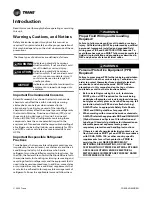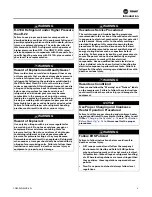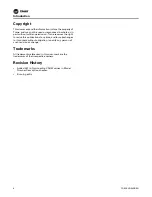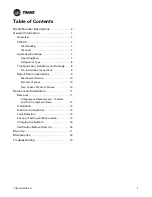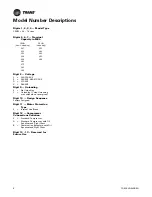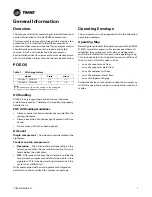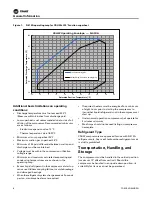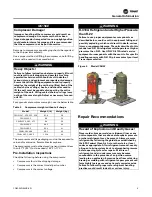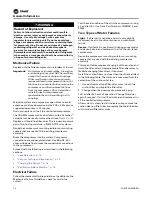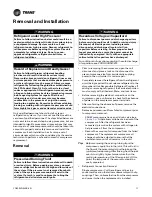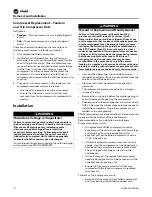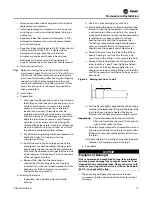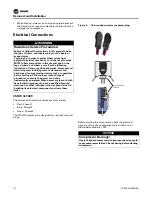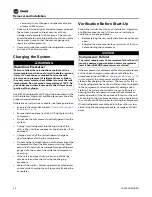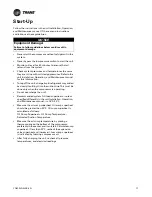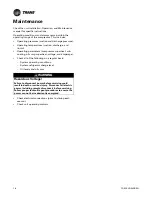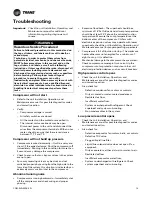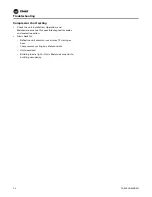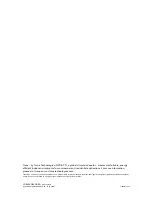
Removal and Installation
COM-SVN003B-EN
15
Leak Detection
Pressure Testing
•
Use industry-standard and EPA-accepted techniques
for testing.
•
Pressure tests must be performed by qualified
personnel.
•
Use tools especially designed for leak testing.
•
Do not exceed the high-side and low-side pressures
listed on the unit nameplate.
•
If no test pressure value is listed on the nameplate of
the unit, a pressure of no more than 150 psig is
acceptable.
•
The CSHW compressor has an internal check valve.
When pressurizing the system, it is important to never
allow the low side pressure to exceed the high side
pressure by more than 5 bar (72 psig). Greater
pressure differential could result in compressor
damage. Also slowly raise the pressure over a
2-minute time period to allow sufficient time for
internal pressures in the compressor to equalize.
•
Pressure decay testing can be used to check for gross
leaks but will not be able to detect the location of a leak.
•
After pressurizing the system use an R-410A leak
detection device to detect and locate leaks.
Vacuum Testing and Evacuation
•
Use the procedure as described in the unit Installation,
Operation, and Maintenance manual.
•
If no other information is available, use the following
information.
•
Ensure that there is no voltage being applied to the
compressor terminals.
•
Evacuate the unit to 500 microns.
•
Hold vacuum for 30 minutes.
•
Rapid pressure rise indicates a leak; locate and repair
the leak.
•
Slow pressure rise indicates one of two possibilities:
–
A small leak, indicated by a continuous rise in
pressure.
–
Moisture in the system, indicated by a slow rise in
pressure and leveling-out at a pressure equivalent
to the moisture level. If this occurs, break the
WARNING
Hazard of Explosion!
Failure to follow instructions below could result in
death or serious injury or equipment or property-only
damage. Use only dry nitrogen with a pressure
regulator for pressurizing unit. Do not use acetylene,
oxygen or compressed air or mixtures containing them
for pressure testing. Do not use mixtures of a hydrogen
containing refrigerant and air above atmospheric
pressure for pressure testing as they may become
flammable and could result in an explosion. Refrigerant,
when used as a trace gas should only be mixed with dry
nitrogen for pressurizing units.
WARNING
Hazardous Pressures!
When using dry nitrogen cylinders for pressurizing units
for leak testing, always provide a pressure regulator on
the cylinder to prevent excessively high unit pressures.
Never pressurize unit above the maximum
recommended unit test pressure as specified in
applicable unit literature. Failure to properly regulate
pressure could result in a violent explosion, which could
result in death or serious injury or equipment or
property-only-damage. See maximum recommended
unit test pressure below.
NOTICE
Overpressure Damage!
Failure to follow these instructions could result in
compressor damage. Do not pressurize the low side of
the compressor by more than 5 bar (72 psig) higher
than the high side of the compressor within less than
two minutes.
NOTICE
Compressor Motor Damage!
Failure to follow these instructions could cause
compressor motor damage. Never use the compressor
as a vacuum pump. Never meg-ohm test or apply
power to the compressor while it is in a vacuum.
WARNING
Hazardous Voltage w/Capacitors!
Failure to disconnect power and discharge capacitors
before servicing could result in death or serious injury.
Disconnect all electric power, including remote
disconnects and discharge all motor start/run
capacitors before servicing. Follow proper lockout/
tagout procedures to ensure the power cannot be
inadvertently energized. Verify with an appropriate
voltmeter that all capacitors have discharged.
For additional information regarding the safe discharge
of capacitors, see PROD-SVB06*-EN.


